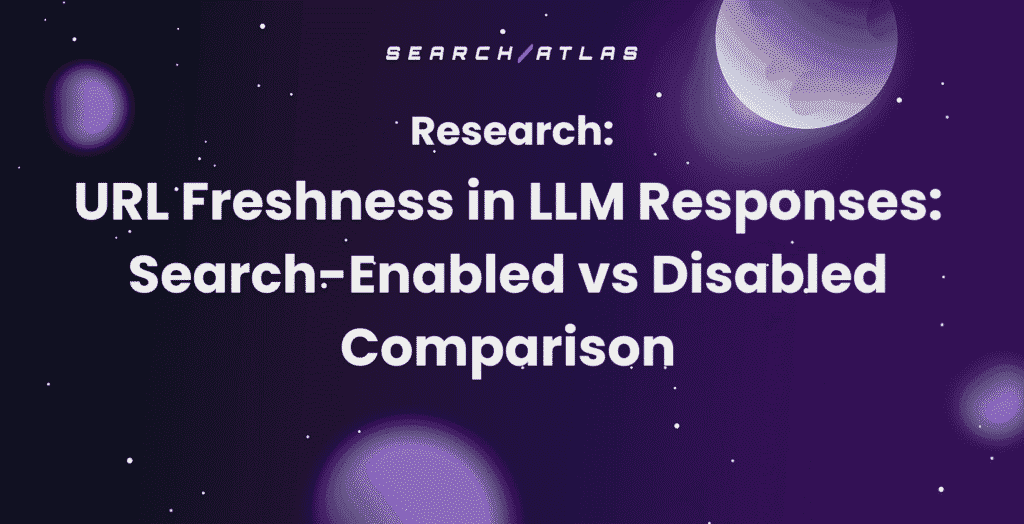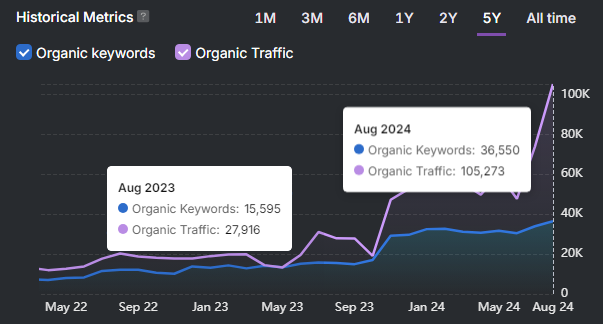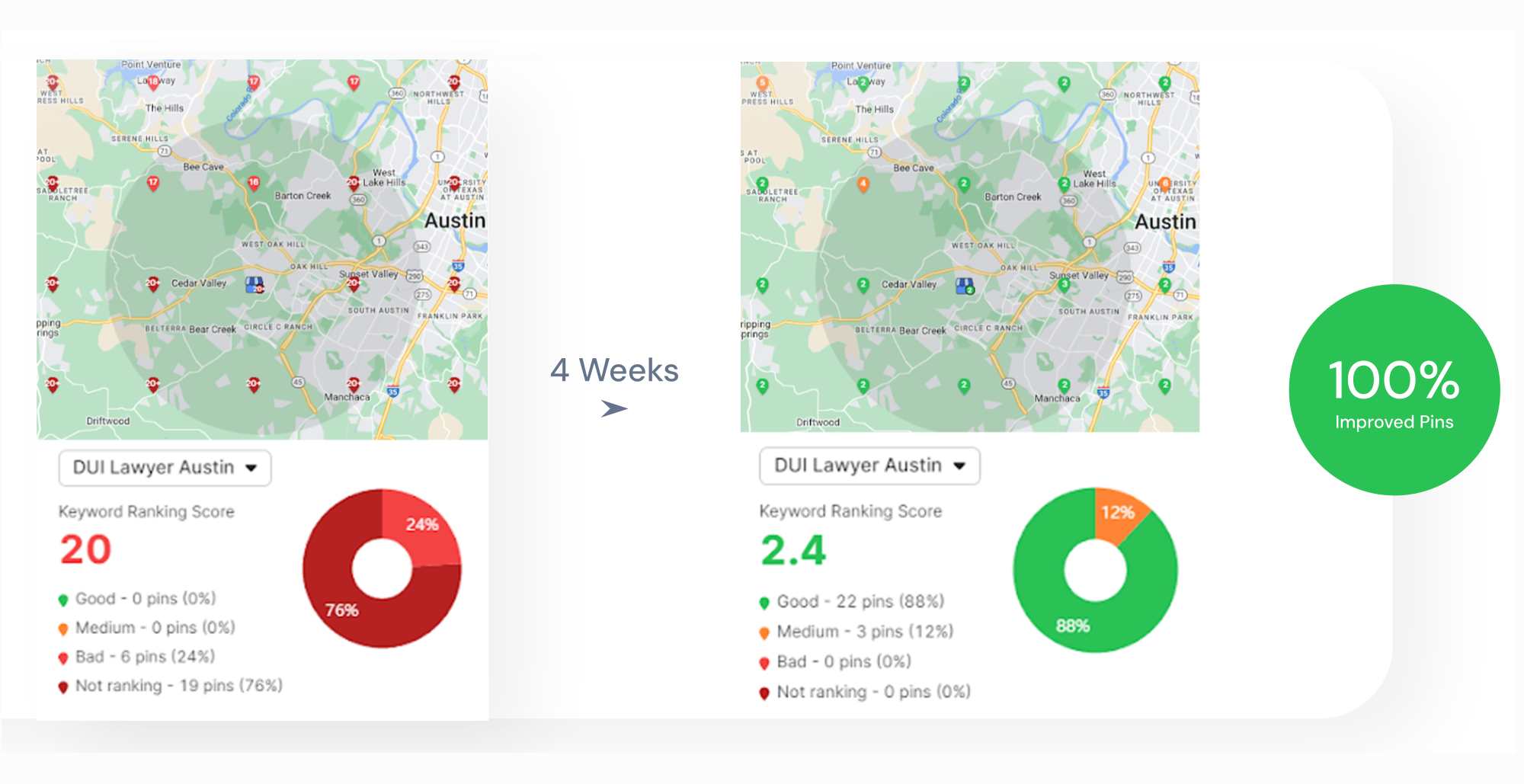An SEO campaign is a coordinated and time-bound effort to improve the visibility of your website on search engines for targeted keywords. An SEO campaign includes keyword targeting, content creation, link building, and technical improvements. SEO campaigns follow a clear sequence of actions and aim to produce measurable results over a defined period.
SEO campaigns matter because they turn long-term SEO strategies into actionable steps. An effective SEO campaign strategy improves rankings, drives qualified traffic, and supports conversions. To launch an effective SEO campaign, you need to define your SEO goals, research relevant keywords, publish optimized content, build high-quality links, and track SEO performance. Use tools for SEO tracking and campaign management to measure results and adjust as needed.
What Is an SEO Campaign?
An SEO campaign is a type of digital marketing strategy that improves search engine rankings for specific queries over a set timeline. SEO campaigns focus on achieving specific goals such as boosting domain authority, ranking new content, fixing crawl issues, or building topical authority for keyword clusters.
Each SEO campaign aligns with a strategic SEO objective, such as improving product page rankings or recovering from traffic loss. Each search engine optimisation example (whether it targets local search, ecommerce queries, or branded traffic) uses a campaign SEO structure.
SEO campaigns typically include keyword research, on-page SEO, content production, technical SEO audits, and link-building outreach. SEO campaign execution follows a phased structure with goals, timelines, and key performance indicators (KPIs).
What Is the Importance of an SEO Campaign?
An SEO campaign boosts ranking eligibility, increases search visibility, and compounds ROI (Return On Investment) over time through organic channels. An SEO campaign framework aligns SEO work with strategic business outcomes.
Campaign-based SEO helps teams prioritize tasks, allocate resources, and measure impact over defined time intervals. SEO campaigns improve focus on specific KPIs like click-through rate, featured snippet wins, or page indexing. This structure reduces SEO inefficiencies and prevents missed opportunities in volatile search engine results pages (SERPs).
For example, launching a content-driven SEO campaign plan around a high-value keyword cluster can increase organic conversions and build topical authority.
In competitive niches, structured SEO campaign management outperforms reactive SEO by delivering cumulative gains for SERP features, user engagement signals, and authority flows.
How to Launch an Effective SEO Campaign?

Launching an effective SEO campaign means executing a structured series of steps that align SEO with your business goals. An SEO campaign process includes research, content development, on-page optimization, authority acquisition, and technical validation. Each step reinforces ranking signals and improves keyword visibility.
The 7 steps to create a high-performing SEO campaign are listed below.
1. Define Your SEO Goals and Target Audience
Defining your campaign SEO goals and target audience sets measurable priorities and ensures relevance to the business.
SEO goals include increasing rankings for transactional keywords, driving traffic to commercial pages, or enhancing visibility in local or product-focused SERPs.
Target audience or buyer personas are defined by role, intent stage, and query behavior. Understand how your audience searches, what formats they prefer (e.g., product pages, comparison tables, how-to guides), and what pain points or objections your content should address.
The best practices for defining your SEO goals and target audience are below.
- Set SMART objectives (Specific, Measurable, Achievable, Relevant, Time-bound).
- Match SEO goals to bottom-funnel KPIs, such as leads, sales, or demo sign-ups.
- Segment goals by audience type, such as B2B, B2C, local, or ecommerce. Learning how to create a winning B2B SEO campaign starts with target audience segmentation.
- Set outcome-based KPIs such as indexed URLs, CTR (click-through rate), or search share.
- Quantify baseline metrics to measure progress.
- Create milestone checkpoints for evaluation and adjustment.
2. Conduct Thorough Keyword Research
Keyword research identifies high-impact queries that match your campaign goals, user intent, and ranking opportunities.
Thorough keyword targeting ensures your SEO campaign prioritizes terms with traffic value and conversion potential. Keyword research sets the foundation for content creation, internal linking, and SERP targeting.
The best practices for keyword research in SEO campaigns are listed below.
- Use the Search Atlas Keyword Research Tool to identify high-volume, commercially relevant keywords within your niche.

- Segment keyword lists by intent type (informational, transactional, navigational, or commercial) in the Search Atlas Keyword Magic Tool to align content with user expectations.
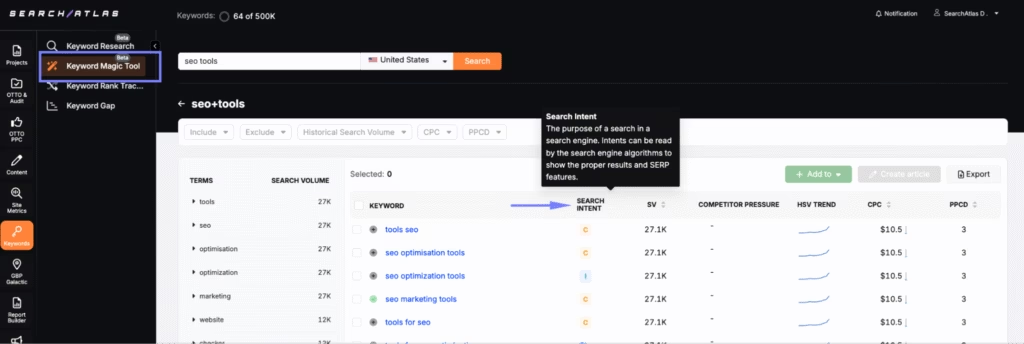
- Find long-tail variations that match specific pain points, locations, or product modifiers.
- Apply the Search Atlas Competitor Keyword Gap Tool to uncover valuable queries your competitors rank for but you do not.
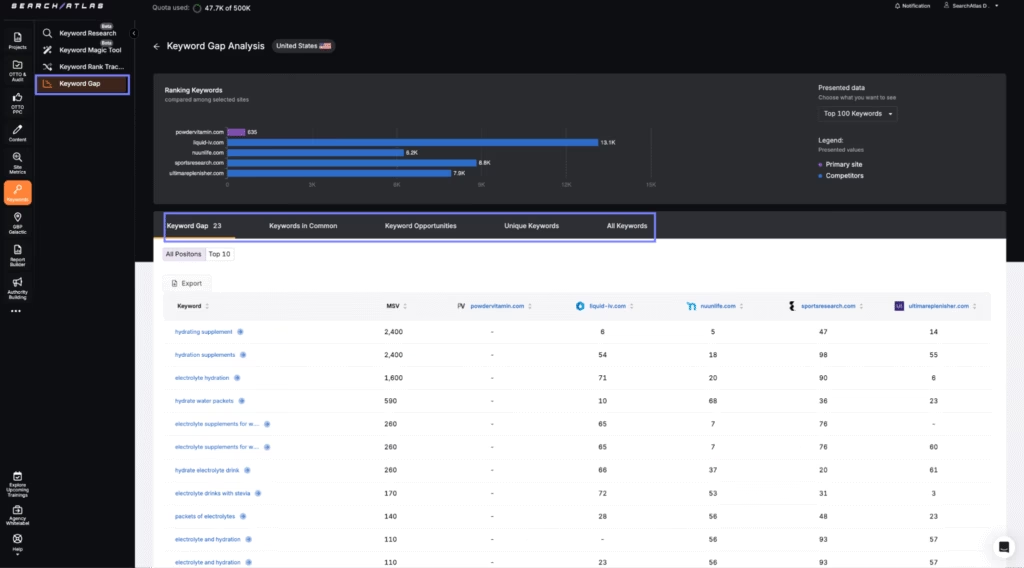
- Prioritize keywords with clear SERP opportunities, low volatility, and achievable competition levels as found in the Search Atlas Keyword Research Tool.

- Filter terms that trigger rich results like featured snippets, FAQs, and video packs.
3. Plan Content Around Topic Clusters
Planning content around topic clusters improves semantic relevance, strengthens internal link equity, and accelerates topical authority.
Topic clusters group search terms under a shared theme, which enables scalable content workflows and deeper SERP alignment.
The tips for topic cluster planning in SEO campaigns are below.
- Use the Search Atlas Content Planner to automatically generate keyword clusters from a seed term or page URL.

- Assign each topic cluster a core keyword based on funnel intent, traffic value, and business alignment.
- Organize supporting queries under the core topic to capture the SERP breadth without cannibalization.
- Review the total topic count to estimate content scope and production pacing.
- Export clusters into a structured editorial calendar for seamless execution.
- Filter and prioritize clusters based on search intent, cost per click (CPC), and competition level.
- Use query intent classification to match each topic with its appropriate format, whether it is an article, a product page, or a landing page.

The Search Atlas Content Planner Tool automates keyword grouping and gives you a production-ready content map that aligns directly with user intent and campaign targets.
4. Create High-Quality, User-Focused Content
Creating high-quality, user-focused content involves targeting intent-driven queries while aligning with SERP layout, term density, and SEO content structure.
Each piece should serve a defined purpose and reflect the exact formatting Google favors for that keyword.
The best practices for creating high-quality, user-focused SEO content are below.
- Use the Search Atlas Content Genius Tool to view NLP-driven topical terms, internal link prompts, and layout benchmarks from ranking competitors.
- Follow the real-time content score to meet optimization thresholds across headings, structure, and paragraph length.
- Integrate high-impact keywords, questions, and semantic phrases directly into copy, headers, and lists.

- Monitor SERP feature triggers, such as image carousels, snippet formats, and PAA (People Also Ask) boxes, to guide formatting.
- Use the Competitor Content Analysis tab of the Search Atlas Content Genius tool to identify layout patterns and missing elements from top-ranking results.

- Track topical term usage and adjust content live based on visual alerts, thresholds, and completeness signals.
- Publish directly to WordPress using the integrated publishing system.
The Search Atlas Content Genius Tool helps scale content that aligns with Helpful Content, EEAT (Experience, Expertise, Authoritativeness, and Trustworthiness), and NLP entity expectations in real-time, before publishing.
5. Optimize On-Page Elements
Optimizing on-page elements turns keyword data and content plans into signals that Google can crawl, parse, and rank effectively. On-page SEO strengthens the web page’s alignment with user intent and reinforces topical relevance for the entire SEO campaign.
Our most effective on-page SEO optimization tips for SEO campaigns are listed below.
- Use the Search Atlas On-Page SEO Audit Tool to check for missing metadata, heading structure issues, keyword placement gaps, and broken links.

- Enhance semantic clarity with Search Atlas OTTO SEO, which automatically rewrites meta tags, optimizes headings, and adds contextual internal links.
- Verify keyword usage and intent alignment by reviewing NLP term coverage and header hierarchy inside the audit report.
- Optimize anchor text, schema markup, and image SEO based on audit suggestions from the Links, Schema, and Image tabs.
- Refresh URL structure to match keyword targeting and content hierarchy.
Search Atlas OTTO SEO updates on-page SEO issues in real-time, which helps campaigns stay compliant with modern ranking systems like Helpful Content and Passage Ranking.
6. Launch a Link-Building Campaign
A link-building campaign enhances authority by acquiring high-quality backlinks from relevant websites. Link equity strengthens domain trust, reinforces campaign content, and improves competitive rankings.
The main steps for a successful link building campaign for SEO are outlined below.
- Use the Search Atlas Backlink Research Tool to evaluate competitor link profiles and find authoritative domains that link to their top content.
- Run the Search Atlas Link Gap Analysis Tool to identify high-value domains linking to your competitors but not to you.
- Build linkable assets like data-driven guides or visual resources and promote them through outreach using the Search Atlas Digital PR Tool.
- Use the WILDFIRE feature within the Search Atlas OTTO SEO to participate in closed-network link exchanges that match by topic and domain power.
- Track new links and anchor diversity using the Search Atlas Site Explorer, and filter by link type, authority, and referring content.
Campaigns earn relevant links that signal topical authority and support higher rankings for target keywords for your SEO campaign through various features within the Search Atlas Link Building Outreach and Digital PR Tool.

7. Address Technical SEO Issues
Addressing technical SEO issues ensures that search engines crawl, understand, and index your website without errors.
Strong technical SEO supports every other SEO effort in your SEO campaign by providing a clean, performant foundation for rankings and user engagement.
Follow the technical SEO best practices listed below.
- Fix crawlability issues with optimized robots.txt, meta robots tags, and structured internal linking.
- Improve Core Web Vitals to meet Google’s Page Experience signals.

- Use semantic HTML5 tags like <header>, <main>, and <section> to support structured understanding.
- Submit a valid XML sitemap and monitor it regularly in Google Search Console and the Search Atlas Site Audit tool’s Page Explorer feature.
- Implement schema markup to help search engines interpret key entities and surface rich results.
- Resolve redirect chains, broken links, and orphaned pages to improve crawl flow and page equity.
- Optimize for mobile responsiveness, security (HTTPS), and accessibility (WCAG compliance).
Use the Search Atlas Site Audit Tool to diagnose and prioritize technical SEO issues for your SEO campaign. Navigate the Issues dashboard to fix crawl depth, canonical conflicts, indexing gaps, and broken internal links. The audit supports continuous optimization, not just one-time cleanup, so every SEO campaign you do has a strong technical support for success.
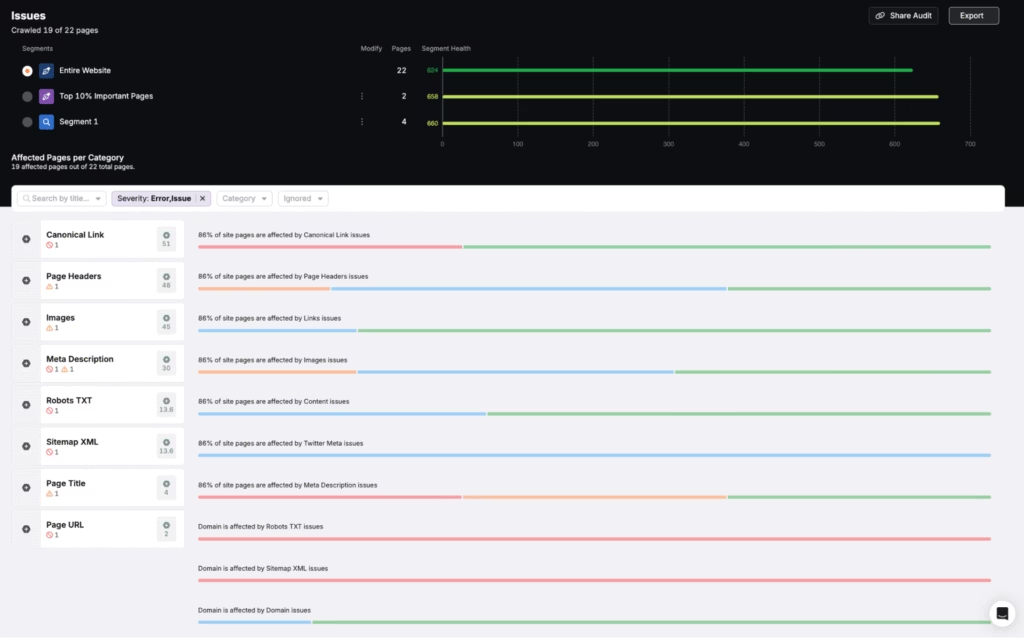
How to Track the SEO Marketing Campaign?
Tracking the SEO marketing campaign validates results, reveals gaps, and guides next-step priorities.
SEO as a marketing strategy risks misalignment with business outcomes and missed growth opportunities if you don’t include SEO campaign tracking.
The 5 steps to track the SEO marketing campaign are listed below.
- Monitor keyword rankings using the Search Atlas Rank Tracker. The Search Atlas Rank Tracker provides a centralized dashboard with average position, search volume, SERP features, and intent tags per keyword. The “Historical Positions” chart highlights movement trends over time. The position distribution panel (e.g., Highest Rank, Traffic, Striking Distance) surfaces where SEO opportunities exist.

- Measure organic traffic, CTR, and conversions. Segment reports by landing page, device, and location for deeper insights.
- Use the Search Atlas Report Builder to consolidate keyword movements, content performance, and link impact into automated dashboards. Export PDF or share live links with clients and stakeholders.
- Compare pre- and post-campaign benchmarks for metrics like indexed URLs, ranking volatility, engagement, and SERP features.
- Set recurring review intervals, such as weekly for rank shifts, monthly for traffic, and quarterly for content and authority signals.
Use the Search Atlas Report Builder to measure SEO campaign outcomes across all major data sources. The Search Atlas Report Builder tool aggregates performance data from Google Analytics, Google Search Console, Google Business Profile, and Google Ads.
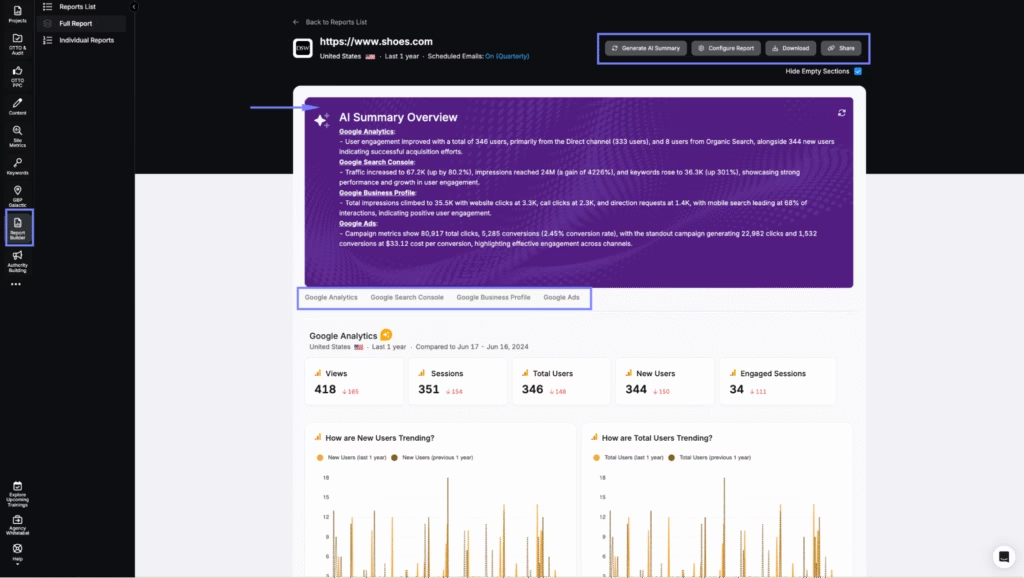
The Search Atlas Report Builder tool’s AI Summary contextualizes ranking changes, traffic shifts, and conversion impact. It directly ties results to specific campaign actions. This helps SEO tracking against original goals, identifying areas for improvement, and prioritizing adjustments for the next SEO campaign cycle.
Are There Any Specific Tools for SEO Campaign Management?
Yes, there are specific tools for SEO campaign management.
Tools for SEO campaign management are the tools that provide features for planning, executing, monitoring, and optimizing all phases of an SEO campaign. SEO campaign management tools unify workflows for keyword tracking, content publishing, link acquisition, and performance reporting. The selection of SEO campaign management tools directly impacts campaign efficiency, visibility, and ROI.
The best tools for SEO campaign management include free tools from Google and paid tools from the Search Atlas SEO software platform. These tools offer complementary capabilities to support both early-stage and advanced SEO initiatives. The best SEO campaign management tools are listed below.
Google Search Console (GSC) serves as the foundational tool for monitoring organic performance. GSC tracks keyword rankings, indexing coverage, page experience, and mobile usability. The URL Inspection Tool diagnoses indexing and rendering status, which helps campaign managers verify optimization progress.
Google Analytics 4 (GA4) measures behavioral metrics and conversion events across SEO landing pages. GA4 shows how users interact with content, tracks engagement funnels, and reveals the highest-converting SEO entry points. SEO campaign managers use GA4 to attribute revenue or leads to organic traffic sources.
Google Looker Studio creates custom campaign dashboards by integrating GSC, GA4, and third-party sources. Looker Studio allows agencies and internal teams to visualize SEO KPIs across channels and reporting periods.
Search Atlas White Label SEO Software manages multi-client SEO campaigns in one interface. The Search Atlas White Label SEO Software includes branded reporting, performance dashboards, campaign calendars, and KPI tracking for agencies running SEO as a service. White label features include logo integration, custom templates, and client portal access.
Search Atlas combines automation, SERP data, and AI optimization into a single SEO command center. Campaign managers use the Search Atlas SEO tools to track progress, make fixes, and scale SEO campaigns.
Combining Google’s free tools with the Search Atlas SEO tools creates a complete SEO campaign management system, ideal for agencies, consultants, and in-house teams that focus on ranking performance and operational efficiency.
Can Multiple SEO Campaigns Be Managed Simultaneously?
Yes, SEO professionals can manage multiple SEO campaigns simultaneously by using SEO campaign management software that supports project-level segmentation, reporting, and automation.
Each SEO campaign may target different keywords, audiences, or goals, such as local SEO for brick-and-mortar locations and product-led SEO for ecommerce sites. SEO project management for multiple SEO campaigns at once requires tools that isolate workflows, track performance separately, and provide unified oversight.
Platforms like Search Atlas support SEO project management and parallel SEO campaign execution by offering multi-client dashboards, automated audits, rank tracking, and AI-powered optimization workflows. Each campaign operates independently while feeding into a centralized reporting system, which allows teams to scale efforts without losing visibility or control.
What Are the Successful SEO Campaign Examples?
Successful SEO campaign examples demonstrate measurable traffic growth, keyword gains, and improved conversion rates in competitive industries. The best SEO campaigns apply technical audits, topic cluster content, local search optimization, and link acquisition to deliver ranking improvements and business outcomes.
The most successful SEO projects include multi-month initiatives across ecommerce, healthcare, law, and enterprise brands.
One standout example of a successful SEO campaign is Dr. David McInnis Orthodontics, which achieved a 472% increase in organic traffic and 380% more patient conversions in just 6 months by using Search Atlas. Their campaign included full technical restructuring and search intent alignment.

Another top-performing case is a national restaurant equipment supplier whose traffic grew 390%, with 609 keywords ranking in the top 3 after implementing OTTO-powered optimization.
Successful SEO campaign examples reflect the compound results of structured campaigns driven by AI-powered tools like OTTO SEO and Search Atlas, which are now used by over 5,000 agencies worldwide.
For agencies managing SEO projects at scale, LinkGraph and its software Search Atlas rank among the top SEO providers globally, with high-impact SEO campaign examples in all industries.
How to Conduct an SEO Campaign ROI Analysis?
Conducting an SEO campaign ROI analysis measures the financial return generated from SEO activities compared to their costs. Return on Investment (ROI) calculations help determine the profitability of SEO as a marketing investment and guide future budget allocation.
The 5 steps to analyze your SEO campaign ROI are outlined below.
- Identify Total SEO Investment. Include agency fees, in-house labor, tools like Search Atlas, and content production costs to get the total cost of the SEO campaign.
- Define Conversion Metrics. Choose trackable KPIs like lead form submissions, demo sign-ups, or sales generated from organic sessions.
- Track Organic Revenue. Use tools like Google Analytics 4 to isolate revenue driven by organic traffic.
- Calculate ROI. Use the formula to calculate ROI. The formula for calculating ROI is (Organic Revenue – Total SEO Cost) ÷ Total SEO Cost × 100.
- Attribute Soft Value. Account for non-monetary wins like domain authority growth, branded search volume, and long-tail visibility.
You should evaluate SEO ROI quarterly, especially for long-term SEO campaigns that target competitive SERPs.
Can SEO Campaign Replace Pay-Per-Click Marketing?
No, SEO campaigns cannot replace pay-per-click (PPC) marketing, but they can reduce long-term dependency on PPC. SEO builds sustainable visibility while PPC offers instant reach.
SEO compounds over time by building organic traffic, trust signals, and authority. PPC drives immediate traffic for new pages or time-sensitive promotions. A balanced SEO strategy uses PPC to cover high-intent keywords early, then shifts budget to SEO as rankings improve.
Use SEO to reduce CAC (Customer Acquisition Cost), then scale reach with Pay-Per-Click Marketing when targeting new verticals.
What to Know About SEO Campaigns Besides a Digital Marketing Campaign?
An SEO campaign focuses exclusively on improving organic search rankings, while a digital marketing campaign combines multiple channels (like paid ads, email, and social media) to reach users. SEO campaigns rely on search behavior and keyword targeting. Digital marketing campaigns rely on audience targeting and media spend.
SEO goals prioritize long-term visibility, quality of traffic, and non-paid conversions. Digital marketing campaigns drive faster results but require continuous investment. A well-structured SEO campaign supports digital marketing efforts by capturing search demand and improving brand presence in the SERPs.
What to Know About SEO Campaign Besides SEO Strategy?
An SEO campaign is a short-term execution plan that targets specific goals, while an SEO strategy is a long-term plan that defines priorities, tactics, and target outcomes. An SEO campaign includes concrete actions such as publishing content, fixing technical issues, or launching a backlink outreach.
A strong SEO strategy outlines the keyword targets, content structure, technical requirements, and authority signals that support organic growth. The SEO strategy sets the scope and the priorities. The SEO campaign follows the sequence defined in the strategy.
What to Know About SEO Campaign Besides the SEO Checklist?
An SEO campaign is a focused execution of tasks with defined objectives, while an SEO checklist is a static reference of best practices. An SEO checklist outlines what to verify. An SEO campaign applies actions based on those checks to achieve a measurable result.
An SEO campaign uses the SEO checklist during each phase of keyword research, content publishing, technical auditing, and link acquisition. The SEO checklist supports consistency and accuracy, but the SEO campaign measures performance and impact.







